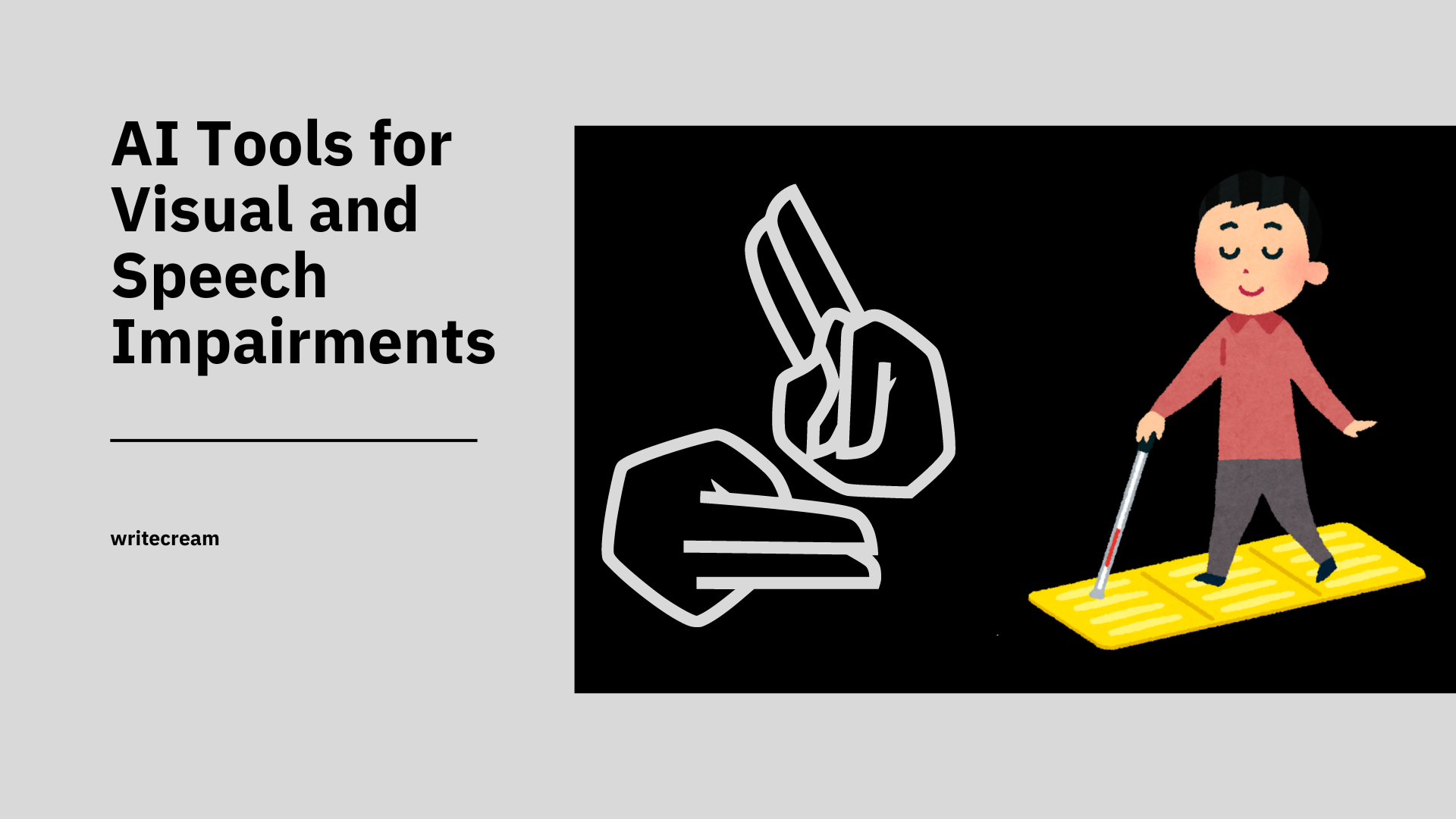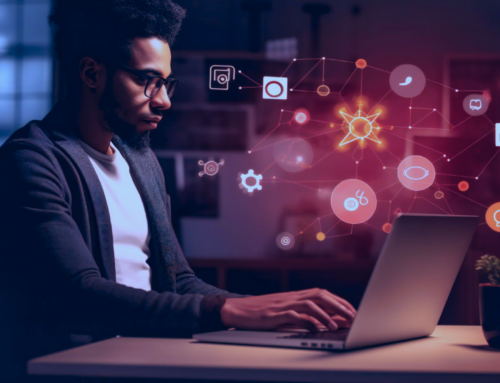When we think about accessibility, we often think about how technology can help people with disabilities lead more independent and fulfilling lives. With AI, we’re witnessing some incredible advancements that are making this possible in ways we couldn’t have imagined a few years ago. But how exactly can AI improve accessibility? Let’s explore this through three main areas: assistive technologies, language translation, and content creation.

How AI Voice Generator and Text to Speech Tools for People with Disabilities Empower Those with Visual or Speech Impairments
For people with visual or speech impairments, daily communication can be a challenge. However, AI voice generators and text-to-speech tools are turning the tables. These technologies are not just helping them communicate; they are giving them a voice, literally and figuratively.
Imagine someone who is visually impaired. Reading regular text might be impossible, but with AI-powered text-to-speech tools, they can listen to emails, articles, or even books. Chris Bajda, a seasoned e-commerce entrepreneur and the Managing Partner of Groomsday, emphasizes, “AI voice generators and text-to-speech tools have revolutionized the way individuals with visual or speech impairments interact with the world. These technologies empower users by providing them with the ability to access information, communicate, and perform tasks independently. For someone with a visual impairment, text-to-speech tools can read out digital content, enabling them to navigate websites, read documents, or even enjoy a good book without assistance. For those with speech impairments, AI voice generators can act as their voice, allowing them to participate in conversations and express their thoughts clearly. This empowerment is not just about convenience; it’s about enhancing quality of life and opening up new opportunities.”
Similarly, for those with speech impairments, AI voice generators can help them express themselves. Instead of relying on others to speak for them, these individuals can now use AI to convey their thoughts clearly and confidently. Abhishek Shah, founder and CEO of Testlify, adds, “AI voice generators and text-to-speech tools empower individuals with visual or speech impairments by converting written text into spoken words, enhancing communication and accessibility. These tools help users access information, perform tasks independently, and personalize their interactions, thereby boosting their autonomy and self-confidence.”
Liudas Kanapienis, CEO and co-founder of Ondato, adds, “AI voice generators and text-to-speech tools have tremendous potential to empower individuals with visual or speech impairments. These technologies can convert written text into natural-sounding speech, enabling visually impaired individuals to access a wide range of written content. For those with speech impairments, AI-powered voice synthesis can provide a means of verbal communication that might otherwise be challenging or impossible.
Can AI Break Down Language Barriers and Aid Communication?
Language is a powerful tool, but it can also be a barrier, especially in a diverse country where multiple languages are spoken. AI-powered language translation tools are breaking down these barriers, making communication seamless and inclusive.
For instance, a person who only speaks Hindi can now communicate with someone who speaks only English, thanks to AI translation tools. Chris Bajda believes that “AI has truly become a bridge in overcoming language barriers, facilitating communication between people from different linguistic backgrounds. These tools offer real-time translation, making it possible for individuals to engage in conversations without needing to learn a new language. Whether you’re traveling abroad or collaborating with international partners, AI translation tools can make interactions smooth and effective. It’s incredible to think about how much more connected we can become when language is no longer a barrier. Businesses can expand globally, and individuals can form meaningful connections across cultures with greater ease.”
In a globalized world, this is more important than ever. Whether it’s for business, education, or personal communication, AI language translation tools are helping people from different linguistic backgrounds connect and communicate effectively. Abhishek Shah notes, “AI tools break down language barriers by providing real-time translation, enabling seamless communication across different languages. These technologies make information accessible to a broader audience, foster cultural exchange, and aid language learners with accurate translations and pronunciation guides.”
In terms of language translation, AI is already making significant strides in breaking down language barriers. Liudas Kanapienis, CEO and co-founder of Ondato, shares, “At Ondato, we’ve seen firsthand how AI-powered translation tools can facilitate communication across our global team spanning 35 countries. For people with different linguistic backgrounds, including those with disabilities, these tools can provide real-time translation of both text and speech, opening up new possibilities for interaction and understanding.”
Can AI Help People with Disabilities Create Art, Text, and Audio?
Content creation is another area where AI is making a significant impact, especially for people with disabilities. Creating art, writing, or producing audio content might seem daunting for someone with physical or cognitive challenges, but AI is changing that narrative.
Take, for example, AI-powered design tools that help individuals create stunning visuals without the need for advanced graphic design skills. Chris Bajda points out, “AI empowers individuals with disabilities to engage in content creation in ways that were once unimaginable. For people who may have difficulty with traditional forms of writing or art due to physical limitations, AI offers new avenues for creativity. Voice-to-text software allows individuals to dictate their thoughts, transforming them into written content. AI-driven art tools can assist in creating visual works by interpreting and executing the user’s ideas. These technologies enable people to explore their creative potential and share their perspectives with the world, fostering inclusion and diversity in content creation. AI isn’t just a tool for convenience; it’s a catalyst for personal expression and innovation.”
Similarly, Artificial Intelligence writing assistants are helping those with cognitive challenges to create written content. By offering suggestions, correcting grammar, and even generating content ideas, these tools make writing more accessible. Abhishek Shah shares, “AI empowers individuals with disabilities to create art, text, and audio content. Tools like eye-tracking for digital art, speech-to-text for writing, and AI voice generators for audio content enable creative expression and participation in content creation, regardless of physical limitations.”
AI’s potential in content creation for people with disabilities is particularly exciting. For instance, AI-powered tools can help individuals with mobility impairments create visual art through eye-tracking or voice commands. For those with cognitive disabilities, AI writing assistants can help structure thoughts and improve written expression. In the audio realm, AI can assist in music composition and sound design, offering new creative outlets.
“AI in accessibility isn’t just about compensating for disabilities – it’s about unlocking new possibilities and empowering individuals to express themselves in ways they never could before,” says Liudas Kanapienis. “At Ondato, we’re exploring how AI can make our identity verification processes more accessible. For example, we’re developing AI-powered systems that can guide visually impaired users through the process of taking a clear ID photo, providing audio cues and feedback.”
While these AI tools offer immense potential, it’s crucial to involve individuals with disabilities in their development to ensure they truly meet user needs. As we continue to advance AI technologies, the goal should be to create a more inclusive digital world where everyone, regardless of ability, can participate fully.
How AI Supports Speech Therapy and Rehabilitation
AI is playing a significant role in speech therapy and rehabilitation, especially for people with disabilities. The use of artificial intelligence in this field allows people with disabilities to access more personalized and effective therapy. AI-powered speech recognition and image recognition technology are transforming accessibility, making it easier for individuals with visual or physical disabilities to participate in therapy. For example, AI algorithms can analyze large amounts of data to provide tailored exercises that meet the specific needs of individuals with cognitive disabilities, including those with dyslexia.
Different kinds of AI voice generator and text to speech tools for people with disabilities, such as those developed by companies like OpenAI, are being used to help people who speak in non-standard ways due to speech impairments. These AI tools can adapt to the unique speech patterns of users, providing real-time feedback and helping them improve their communication skills over time. This approach not only includes people with disabilities in the therapy process but also enhances the effectiveness of the therapy itself. As the technology becomes more advanced, AI can support a wider range of needs within the disability community.
The use of AI in speech therapy and rehabilitation is not just about improving individual outcomes; it also helps include people in the broader conversation about accessibility. AI can also help people with physical disabilities by providing alternative ways to communicate and interact with others. This is particularly important for individuals with cognitive disabilities, who may find traditional therapy methods challenging. By making speech therapy more accessible and personalized, AI is opening up new possibilities for the disability community, ensuring that everyone has access to the support they need to communicate effectively.
When AI Gets It Wrong
One challenge with AI voice generator and text to speech tools for people with disabilities is when they don’t quite hit the mark emotionally. For instance, if someone uses an AI tool like ChatGPT to convert text to speech, the voice might sound too flat or robotic. This can be especially tricky when the speech needs to convey emotion, like joy or sadness. While AI can help by offering speech recognition and language processing to understand the words, it doesn’t always grasp the feeling behind them. The recognition technology might read everything in the same tone, making the speech sound lifeless. This can be frustrating for people with disabilities who rely on these tools to communicate effectively.
Can Technology Preserve Accents and Dialects?
When we talk about AI voices, especially in tools like text-to-speech and voice generators, one big question arises- can AI preserve cultural identity through accents and dialects? This is important because accents and dialects are not just ways of speaking; they carry the essence of a community’s cultural identity. For people with disabilities, especially those with learning disabilities or cognitive disabilities, having AI voices that reflect their own accent can make a big difference in how they connect with technology and how comfortable they feel using it.
Improving Accessibility through Cultural Representation:
AI can assist in improving accessibility for people with disabilities by recognizing and preserving their native accents and dialects. When AI voices match the way a person naturally speaks, it helps disabled people, including those with hearing impairments, feel more understood and valued. This cultural representation can also make it easier for people with disabilities to communicate, as they feel more at home with the technology.
Supporting Diverse Communities:
Tools like ChatGPT and other AI-driven assistive technologies can be tailored to reflect different accents and dialects. This is especially helpful for students with disabilities who may struggle with speech-to-text software that doesn’t recognize their unique way of speaking. By incorporating diverse linguistic features, these tools for people with disabilities can better serve a wide range of users, ensuring that everyone, regardless of their background, can benefit from AI.
Impact on the Lives of Disabled People:
The use of AI to preserve cultural identity in voices can significantly impact the lives of people with disabilities. For instance, those with cognitive disabilities or learning disabilities can better engage with technology that speaks their language. Recognition software that understands different dialects makes it easier for people with disabilities to interact with AI, ultimately improving their accessibility and communication. By embracing this diversity, AI has the potential to enhance the lives of many disabled people across the world.
The Psychological Impact of Constant AI Voice Assistance
AI voice assistance is becoming a common part of our daily lives, especially for people with disabilities. While these tools offer many benefits, there are also concerns related to the psychological impact of relying on them constantly. For instance, people with limited mobility or those who use speech recognition software for communication may begin to feel overly dependent on AI tools. This can affect their self-confidence and independence, as they might worry about whether they can manage without AI support.
Balancing Independence and Assistance:
AI tools like ChatGPT and real-time voice recognition can help improve digital accessibility by making it easier for people with disabilities to access information and interact with digital content. However, it’s important to balance this assistance with promoting independence. For instance, speech-to-text and image recognition technology can also be used to complement other forms of communication, like sign language, rather than completely replacing them. This way, people with non-standard speech patterns or those who rely on assistive technology can have a more holistic approach to communication.
Impact on Learning and Social Interaction:
AI voice assistance can enhance learning experiences for people with disabilities by offering personalized support. However, there are psychological concerns related to how constant interaction with chatbots or voice assistants might impact social interactions. For instance, if people with disabilities primarily interact with AI instead of human beings, they might feel isolated. It’s important for AI developers to consider these impacts when developing AI tools, ensuring that the technology helps without reducing human contact. AI tools should be designed to foster social connections, not replace them.
Ensuring Positive Outcomes:
To address these psychological concerns, leveraging AI in a way that enhances rather than replaces human interaction is crucial. Here are some key considerations:
- Use AI to support, not replace, human communication: AI tools like ChatGPT should enhance the communication abilities of people with limited mobility without replacing their need for human interaction.
- Encourage diverse learning experiences: Incorporate AI in ways that support a variety of learning experiences, such as combining AI-driven content with traditional learning methods.
- Promote digital accessibility: Ensure that AI tools improve the accessibility of digital content without leading to over-reliance.
- Consider social and emotional impacts: Developers should be mindful of the potential isolation that could result from over-reliance on AI chatbots or voice assistants.
- Design with a focus on mental well-being: AI tools should be created with the psychological well-being of users in mind, fostering a balance between AI assistance and human interaction.
By considering these aspects, AI voice assistance can be a powerful tool that enhances the lives of people with disabilities while also addressing potential psychological impacts.

Financial Barriers to Cutting-Edge AI Voice Tools
While AI voice tools have the potential to greatly assist individuals with disabilities, the financial barriers to accessing these cutting-edge technologies are significant. High costs often limit the availability of advanced AI language tools that can generate human-like speech or provide assistance with tasks like adjusting the temperature or navigating the job application process. This makes it difficult for individuals with limited financial resources to benefit from the full range of AI’s capabilities. For example, people with mobility impairments who could use these tools to read out loud or help with written and spoken communication might not have the means to access them.
Making AI More Accessible
Despite the potential benefits of AI, such as helping individuals with mobility impairments or allowing users to type and communicate more easily, financial barriers prevent many from fully utilizing this technology. Machine learning algorithms that drive these tools are often costly to develop and maintain, leading to high prices for the end-user. To truly make the world more inclusive, it’s important to find ways to lower these financial barriers so that more people can access and benefit from AI. By making AI voice tools more affordable, we can help individuals with disabilities experience the advantages of AI in their daily lives.


